RAMAYANA TOUR
(10 days / 09 Nights) - RAMAYANA TOUR
Day 01

AIRPORT TO ANURADHAPURA
- Visit Munneswaran Kovil-Chilaw
Munneswaram Temple
Munneswaram Hindu Kovil, located near Chilaw in the North Western Province of Sri Lanka, is one of the oldest and most revered Hindu temples in the country. It is part of the Munneswaram temple complex, which includes several shrines dedicated to Hindu deities, with the central shrine dedicated to Lord Shiva. The temple is believed to date back to the 10th century or earlier, with mythological connections to the epic Ramayana. According to legend, it is said that King Rama, after defeating the demon king Ravana, stopped at this location to seek Shiva’s blessings to absolve himself of the sin of killing Ravana, who was a devotee of Lord Shiva.
The architecture of the Munneswaram Kovil is distinctly Dravidian, characterized by towering gopurams (gateway towers), ornate carvings, and statues of Hindu gods and goddesses. The temple has undergone several renovations and restorations over the centuries, with its current structure reflecting both ancient and more recent influences. The temple is also famous for its vibrant festivals, particularly the annual Munneswaram Festival (also known as the Munneswaram Temple Thiruvila), which lasts for about four weeks, usually between August and September. This festival attracts thousands of devotees and pilgrims from all over Sri Lanka and India. The celebrations include rituals, processions, and cultural performances, culminating in the water-cutting ceremony (Theertham) at the Deduru Oya River.
Apart from its religious significance, Munneswaram Kovil is a symbol of cultural harmony, as it is a shared place of worship for both Hindus and Buddhists in Sri Lanka.
Day 02
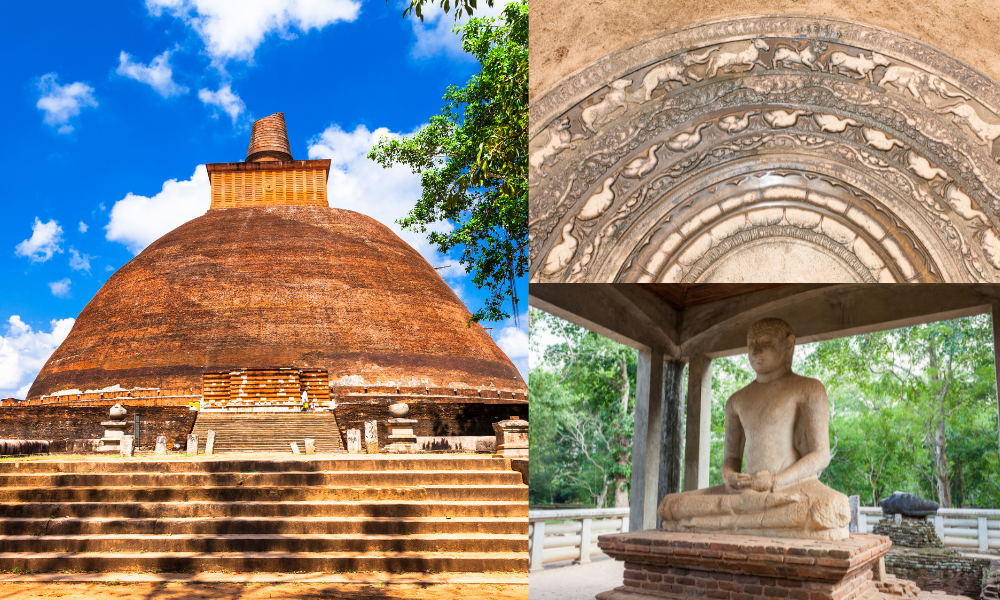
ANURADHAPURA
- Ruwanweli Maha Seya
- Jaya Sri Maha Bodhiya
- Kuttampokuna
Ruwanwali Maha Saya
Ruwanweliseya is one of the most venerated Buddhist sites in Sri Lanka built by the great king Dutugamunu who reigned from 137 BCE to 119 BCE from Anuradhapura. Ruwanweli Maha Seya is not the largest nor the oldest of the stupas erected in Anuradhapura, but this is the most venerated by the Buddhists surpassing all other great stupas. It has the most imposing collection of relics of Gautama Buddha than was ever enshrined in any other dagoba on the island.
Jaya Sri Maha Bodhi
Jaya Sri Maha Bodhi is a sacred Bo tree, that stands in the Mahamewna Gardens in Anuradhapura Sri Lanka. Not only is it the closest authentic living link to Gautama Buddha, it is also the oldest humanplanted tree in the world with a known planting date and a recorded history.
Kuttam Pokuna
Kuttam Pokuna or the twin ponds is another hydrologic engineering marvel of ancient Sri Lanka. These two ponds belong to the Abayagiri aramic complex and have probably been used by the monks for bathing. The origins of these ponds are not known but it is thought to have been built during the reign of King Aggabodhi I (575-608). It can be seen that the smaller pond (the northern) was constructed first and the larger one at a later stage from the fine architectural differences between the two. They are connected through a pipeline at the bottom. The northern pond is 91 feet (28 meters) long and the other is 132 feet (40 meters). Both are 51 feet (15.5 meters) wide and there is a gap of 9 feet (2.7 feet) between the 2 ponds. In the northern pond, there are 2 flights of stone steps each with 20 steps with a simple balustrade. The southern pond has 3 flights of steps each with 18 stone steps broken into 3 stages with an equal number of balustrades. The pots of plenty (Punkalasa’s) at each pond differ from each other.
Day 03
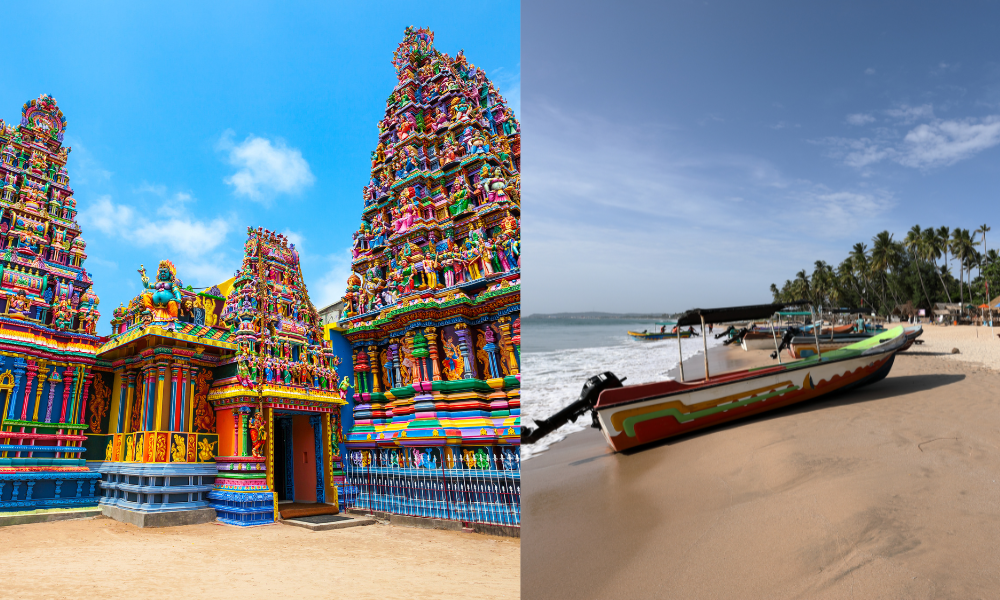
ANURADHAPURA TO TRINCOMALEE
- Visit Koneshvaran Kovil
- Town visit
- Enjoy at beach
Thirukoneswaram Kovil
Koneswaram Temple or Thirukonamalai Temple is dedicated to Lord Shiva. Surrounded by jawdropping scenery, the temple is believed to be one of the Panch Ishwarams (five abodes of Shiva) of Sri Lanka along with Ketheeshwaram, Munneshwaram, Naguleshwaram and the now destroyed Tenavaram. The site is a religious pilgrimage for the Hindus and is also known as the Kailasa of the South as it lies on exactly the same longitude as Mount Kailash. Koneswaram gets its name from the chief deity of the temple that is God Shiva.
Town Visit
Trincomalee, located on the northeastern coast of Sri Lanka, is a historic port city known for its natural harbor, pristine beaches, and rich cultural heritage. A city tour of Trincomalee includes visits to iconic sites such as the Koneswaram Temple, a revered Hindu shrine perched on a cliff overlooking the ocean, and Fort Frederick, a colonial-era fort offering panoramic views of the coastline. The city is also home to the serene Nilaveli Beach, the Pigeon Island National Park with vibrant marine life, and the Commonwealth War Cemetery. Trincomalee’s blend of history, culture, and natural beauty makes it a captivating destination for visitors.
Nilaweli Beach
Nilaveli is a coastal resort town and suburb of the Trincomalee District, Sri Lanka located 16 km northwest of the city of Trincomalee. A historically popular Tamil village and tourist destination of the district alongside the nearby Uppuveli, the numbers of visitors declined following the 2004 Indian Ocean tsunami and Sri Lankan Civil War, but have risen again since 2010. Pigeon Island National Park, one of the two marine national parks of the region is situated 1 km off the coast of Nilaveli, its many species of vegetation, coral and reef fish contributing to Nilaveli’s rich biodiversity.
Day 04
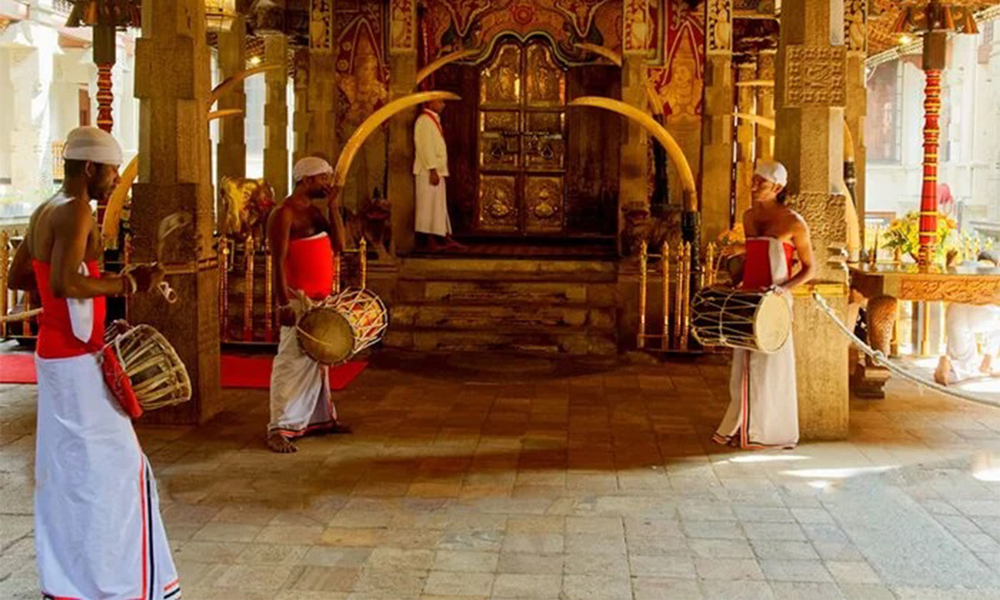
TRINCOMALEE TO KANDY
- Sigiriya
- Visit Daladamaligava Temple
- Botanical garden
Sigiriya Lion Rock
Sigiriya Lion Rock is an ancient rock fortress known for its massive column of rock that reaches nearly 200 meters high. The site dates back to the reign of King Kasyapa (477-495 AD), who chose this site as his new capital. He decorated the walls with frescoes, and built an impressive palace right on top of the rock column, accessible only through the mouth of an enormous carved lion.
Temple of The Tooth Relic (Sri Dalada Maligawa)
The Temple of the Tooth Relic (Sri Dalada Maligawa) in Kandy, Sri Lanka, is one of Buddhism’s most sacred sites, enshrining the revered tooth relic of Lord Buddha. This relic, which arrived in Sri Lanka in the 4th century AD, has been a symbol of both religious and political authority, with the belief that whoever holds it has the right to govern the country. The temple is a key part of the royal palace complex and showcases traditional Kandyan architecture with ornate carvings and a golden roof. Daily rituals are performed, and devotees flock to offer prayers. The annual Esala Perahera festival, one of the most vibrant in the country, features colorful processions with elephants, dancers, and drummers. Recognized as a UNESCO World Heritage Site, the temple is not just a place of worship but also a vital cultural and historical monument in Sri Lanka, attracting pilgrims and visitors from around the world.
Peradeniya Botanical Garden
The Royal Botanical Garden in Peradeniya, Sri Lanka, is a renowned botanical garden located near the city of Kandy. Established in 1821, it covers approximately 147 acres and is home to over 4,000 species of plants, including orchids, spices, medicinal plants, and palm trees. The garden is particularly famous for its stunning orchid collection and the Avenue of Palms. It also features a giant Javan fig tree, a memorial garden, and beautifully landscaped lawns, making it a popular destination for both tourists and locals. The garden plays a crucial role in conservation, research, and education.
Day 05

KANDY TO NUWARA ELIYA
- Visit Seetha Temple
- Hanuman Temple
- Gayathri Temple
- Botanical garden Hakgala
Seetha Amman Temple
The Seetha Amman Temple in Nuwara Eliya, Sri Lanka, is a significant Hindu temple dedicated to Sita, the consort of Lord Rama in the Ramayana. Located in the village of Seetha Eliya, the temple is believed to mark the spot where Sita was held captive by the demon king Ravana.
Hanuman Temple Ramboda
The Hanuman Temple in Ramboda, Sri Lanka, is a sacred site dedicated to the Hanuman. It is situated in the picturesque town of Ramboda, known for its scenic beauty and cascading waterfalls. The temple is perched on a hill, offering stunning views of the surrounding tea plantations and mountains.
Gayathri Temple
The Gayathri Temple in Nuwara Eliya, Sri Lanka, is a significant Hindu temple dedicated to the goddess Gayathri, the mother of the Vedas. Situated in the scenic hill town of Nuwara Eliya, the temple is a place of worship for the Tamil community and attracts devotees and visitors alike. The temple is known for its serene atmosphere, surrounded by lush greenery and misty hills. It plays an important role in the religious and cultural life of the local Hindu population and is a site for various rituals and festivals throughout the year, particularly during the annual Navaratri celebrations.
Victoria Park Nuwara Eliya
Victoria Park in Nuwara Eliya, Sri Lanka, is a beautifully landscaped public park located in the heart of the town. Established in 1897 to commemorate Queen Victoria’s Diamond Jubilee, the park covers about 27 acres and is a popular spot for both locals and tourists. It features well maintained gardens with a wide variety of flowering plants, including roses and exotic blooms, especially vibrant during the spring and summer seasons. The park is also a haven for birdwatchers, as many species of endemic and migratory birds can be spotted here. With its peaceful ambiance, winding paths, and children’s playground, Victoria Park is an ideal place for leisurely strolls, picnics, and relaxation.
Day 06

NUWARA ELIYA TO ELLA
- Visit Ravana caves in Ella
- Nine Arch
- Ravana waterfall
Rawana Caves
It is one of the most important tourists attractions with an historical value in Ella. The history of the Ravana cave is that King Ravana used this cave to hide the Princess Sita. The Ravana cave consists of a part of the tunnel which is connected to the ravana falls in Ella.
Ravana Waterfalls
Ravana Waterfalls, located near the town of Ella in Sri Lanka, is one of the country’s most famous and picturesque waterfalls. Cascading down from a height of about 82 feet (25 meters), the waterfall is part of the Ravana Ella Wildlife Sanctuary and is named after the legendary King Ravana from the Indian epic Ramayana. The falls are surrounded by lush greenery and rocky outcrops, creating a stunning natural setting. During the rainy season, the waterfall becomes more powerful and dramatic, making it a popular spot for both tourists and locals. The area around the falls is also steeped in folklore, with caves nearby that are believed to have been used by King Ravana himself.
Nine Arch
Commissioned under the British in the year 1921, the Nine Arch Bridge stands proudly, a testamen to the engineering and architectural brilliance of the early 20th century.The Nine Arch Bridge, also known as the ‘Bridge in the Sky’ was constructed by connecting two bog mountains when constructing the Badulla – Colombo railway. This bridge is 300 feet in length, 25 feet in width and 80-100 feet in height. It is one of the best examples of colonial-era railway construction in the country.
Day 07
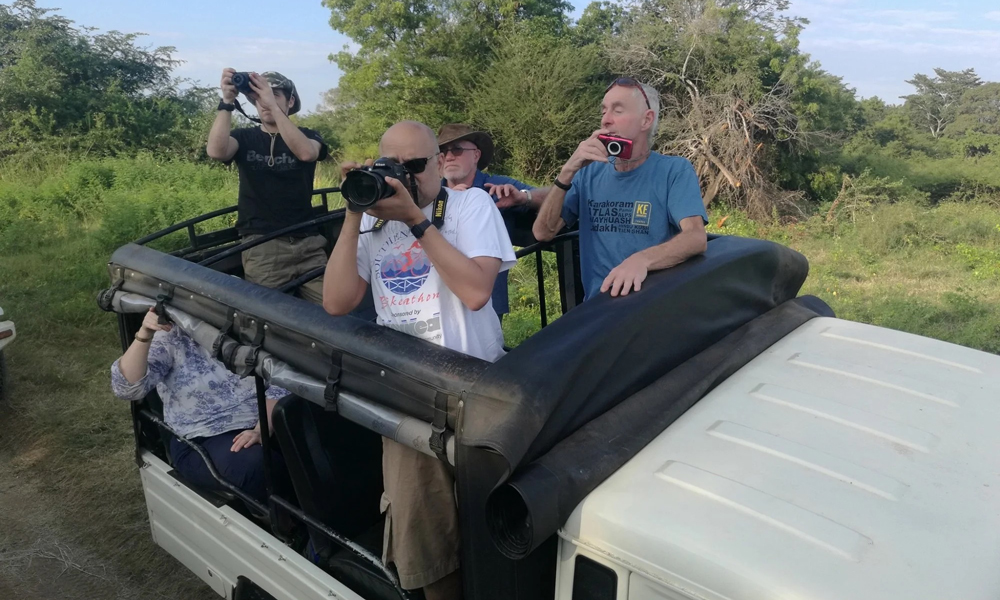
ELLA TO KATARAGAMA
- Yala forest safari
- Visit Dewalaya
Yala National Park
Yala National Park, located in the southeast of Sri Lanka, is the country’s most famous and second largest national park, covering nearly 979 square kilometers. Renowned for its rich biodiversity and stunning landscapes, Yala is particularly famous for having one of the highest densities of leopards in the world, making it a prime destination for wildlife enthusiasts. The park is divided into several blocks, with Block 1 being the most visited due to its abundant wildlife.
In addition to leopards, Yala is home to a wide variety of animals, including elephants, sloth bears, crocodiles, and a diverse range of bird species. The park’s terrain is a mix of dry woodland, open grasslands, and coastal lagoons, providing a unique habitat for its inhabitants. Visitors can embark on guided safaris to explore the park’s natural beauty and observe wildlife in their natural environment. Yala’s blend of wildlife, history, and rugged scenery makes it one of Sri Lanka’s most popular and captivating attractions.
Katharagama Maha Dewalaya
Kataragama Maha Devalaya is a major religious site in southern Sri Lanka, revered by Buddhists, Hindus, Muslims, and indigenous Vedda people. The temple is dedicated to Kataragama Deviyo, a deity worshipped in various forms, including as the Hindu god Murugan. It is a key pilgrimage site, especially during the annual Esala Perahera festival, which features colorful processions and traditional rituals. The temple complex’s multireligious significance and serene atmosphere make it a unique and important spiritual destination in Sri Lanka.
Day 08

KATARAGAMA TO GALLE
- Visit Galle town
- Peace Pagoda
- Unavatuna beach
Galle city
Galle, a coastal city in southwestern Sri Lanka, is renowned for its rich history and stunning architecture. The centerpiece of the city is the Galle Fort, a UNESCO World Heritage Site originally built by the Portuguese in the 16th century and later expanded by the Dutch. This well-preserved fort is a labyrinth of cobblestone streets lined with colonial era buildings, museums, art galleries, and cafes, offering a unique glimpse into Sri Lanka’s colonial past.
Beyond the fort, Galle is known for its beautiful beaches, vibrant markets, and the iconic Galle Lighthouse, which overlooks the Indian Ocean. The city’s blend of cultural heritage, seaside charm, and contemporary lifestyle makes it a standout destination for visitors to Sri Lanka.
Peace Pagoda
The Peace Pagoda, located in Galle, Sri Lanka, is a prominent Buddhist stupa dedicated to promoting peace and harmony. Built in 2004 by the Japanese Buddhist organization, Nipponzan Myohoji, the pagoda is situated on a hill offering panoramic views of the surrounding area, including the city of Galle and the Indian Ocean.
The structure is characterized by its white dome and serene surroundings, which create a tranquil environment for meditation and reflection. The Peace Pagoda is part of a global initiative to build pagodas in various countries to spread the message of peace and unity. Its picturesque setting and peaceful ambiance make it a significant landmark and a place of contemplation for both locals and visitors.
Unawatuna Beach
Unawatuna Beach, located near Galle on Sri Lanka’s southwestern coast, is a popular destination known for its picturesque beauty and vibrant atmosphere. The beach features golden sands, clear turquoise waters, and a crescent shaped bay, making it ideal for swimming, sunbathing, and relaxation. The calm, shallow waters are perfect for water sports like snorkeling and diving.
The area around Unawatuna Beach is bustling with beachfront cafes, restaurants, and boutique shops, offering a range of dining and shopping experiences. The beach is also home to several guesthouses and resorts, making it a convenient base for exploring the nearby Galle Fort and other attractions. Its laid back vibe, combined with its natural beauty, makes Unawatuna Beach a favorite spot for both tourists and locals.
Day 09

GALLE TO COLOMBO
- Visit Sri Anjaneyar Temple
- Visit Kelaniya Temple
Sri Anjaneyar Temple
The Sri Anjaneyar Temple in Colombo, Sri Lanka, is a prominent Hindu temple dedicated to Lord Hanuman, a central figure in Hindu mythology known for his devotion and strength. Located in the heart of Colombo, this temple is an important religious and cultural site for the local Tamil Hindu community.
The temple features vibrant and detailed sculptures of Hanuman, as well as other deities from Hindu tradition. It serves as a center for worship, prayer, and religious festivals, attracting devotees from across the city. The temple is known for its festive atmosphere during major Hindu festivals and for its role in preserving and promoting Hindu cultural practices in Colombo.
Kalaniya Temple
The Kelaniya Raja Maha Vihara, or Kelaniya Temple, is a revered Buddhist temple located near Colombo, Sri Lanka. Believed to be visited by the Buddha during his third visit to Sri Lanka, the temple is known for its historical significance and stunning murals by artist Solias Mendis. The complex features a large stupa, various shrines, and beautifully landscaped gardens. It is a major site for Buddhist worship and festivals, including the colorful Esala Perahera procession.
Day 10
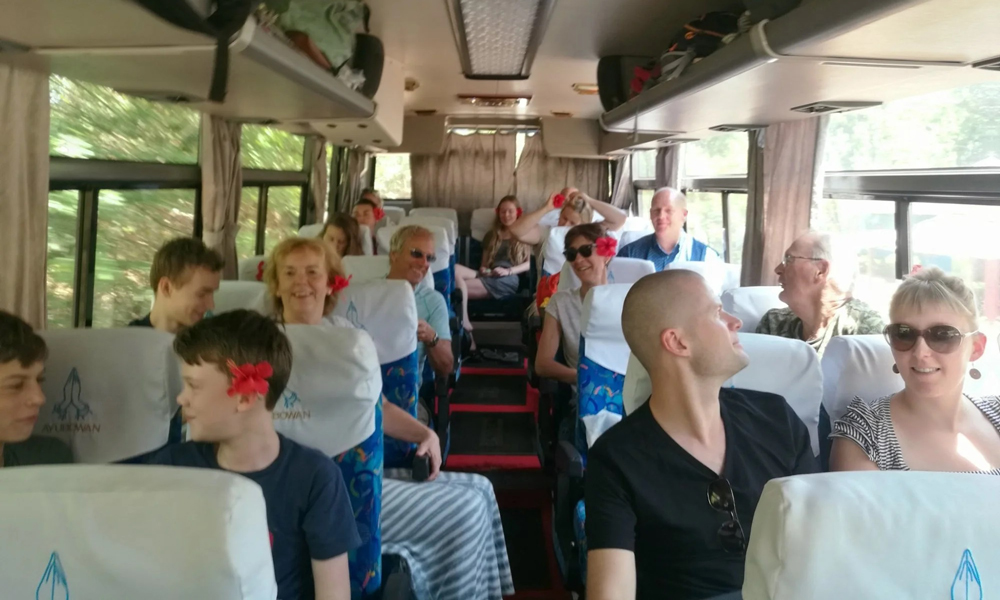
COLOMBO TO AIRPORT
COLOMBO CITY TOUR AND DEPARTURE
PRICE DETAILS
Total tour cost for per person = 600 USD Per Person (Accommodations, Transport and Breakfast.)
Includes
• English speaking chauffeur/guide
• SIM card
• All government taxes
• Air condition vehicle
• Hotels(3 star) with Bed & Breakfast basis
• 2 bottles of water per person per day
Excludes
• All entrance fees with the sightseeing
• Dinners & Lunches
• Tip
Other personal expenses
